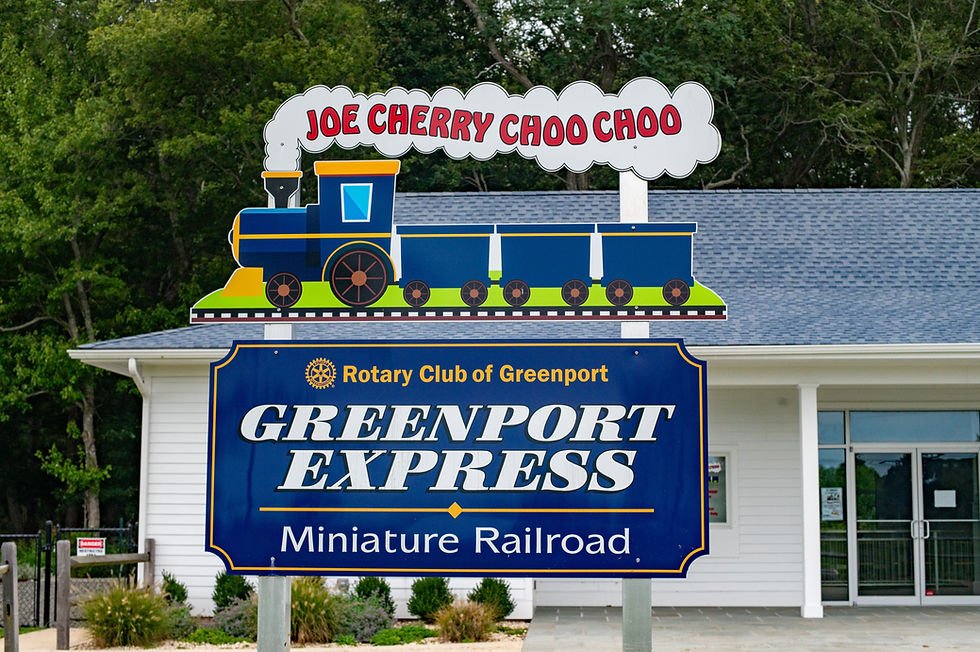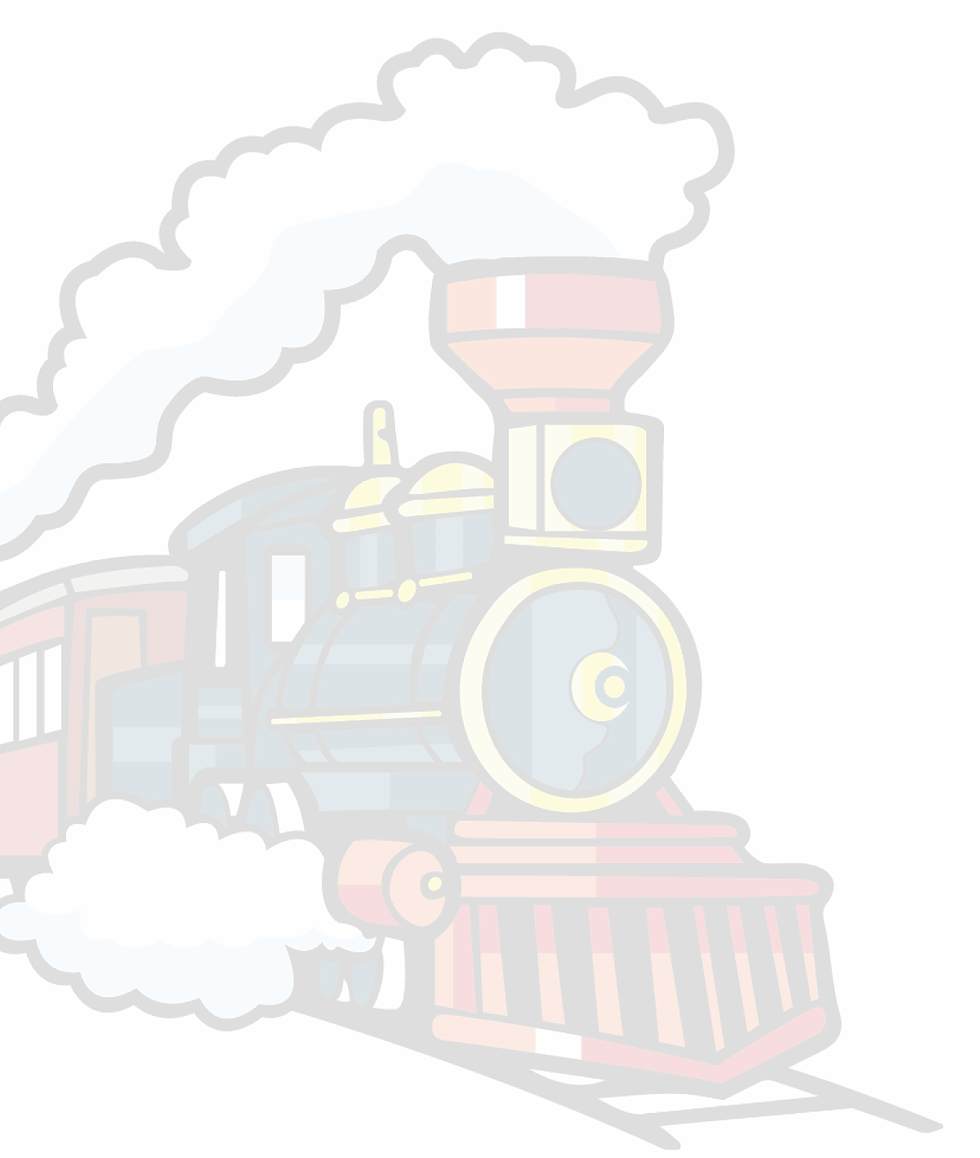Special thanks to our MAIN HALLOWEEN SPOOKTACULAR sponsors: Claudio’s and Eastern Tire. See the full list on our Spooktacular Event Page

Our History
From humble beginnings to where we stand today, our journey has been shaped by passion, perseverance, and a commitment to growth.
A Classic Train Is Born – The miniature locomotive and cars that would later charm Greenport were originally built in Indiana in the late 1940s by what became the Allan Herschell Company. These vintage machines, lovingly restored decades later, are the heart of today’s ride.
1
Late 1940s
Frank’s Dream Begins – After a long career with the Long Island Rail Road, Frank Field retired to Greenport and began dreaming of building a miniature railroad for local kids. His tinkering in the backyard would become a magical tradition for generations.
2
Early 1970s
Webb Street Rides – By 1984/85, Frank invited the public to ride his little blue train on weekends and holidays. Halloween rides became legendary, and thousands of children and families laughed and screamed with delight.
3
1984–85
Hometown Hero Honored – Recognizing his generosity and joy‑bringing, the Greenport Rotary named Frank Field a Paul Harris Fellow in 2006 for running the miniature railroad and donating proceeds to Eastern Long Island Hospital.
4
2006
Farewell, Webb Street – After 27 years, the Peconic County Miniature Railroad gave its final ride on Sept. 3, 2012, closing due to rising insurance costs and dwindling volunteers. The North Fork mourned the end of an era.
5
Sept 3, 2012
Dream to Restore – Joe Cherepowich formally proposed reviving the railroad to the Rotary Club. He quickly won the support of Mayor George Hubbard and the village board.
6
2015
First Steps Toward Revival – At an October fundraiser, Rotarian Joe Cherepowich shared an idea with Frank: why not bring the train back? Within weeks he and Mayor George Hubbard met with Rotary and village leaders to discuss finding a new home on Moore’s Lane.
7
Oct/Dec 2016
Train Bought & Restoration Begins – The Greenport Rotary purchased Frank’s train in 2017 and launched a major fundraising campaign to rebuild the track and restore the locomotives. This was the first tangible step toward bringing the magic back.
8
2017
Community Fundraisers – A grassroots fundraiser in 2018, spearheaded by restaurateur George Giannaris and other Rotarians, rallied the community to raise the money needed for a permanent home and station. The response and generosity was overwhelming.
9
2018
The ‘Joe Cherry Choo Choo’ Debuts – During a ceremonial unveiling near the Moore’s Lane site, the Rotary proudly displayed a banner renaming the train the ‘Joe Cherry Choo Choo’ in honor of Joe Cherepowich.
11
Sept 2019
Breaking Ground on a New Station – Volunteers and donors gathered for a groundbreaking ceremony on Oct. 15, 2022. The dream was becoming real.
10
Oct 15, 2022
Grand Opening at Moores Lane – After nearly a decade of hard work and more than $1 million in donations, the Greenport Express reopened at its new Moores Lane route on June 29, 2024. Dozens of North Fork families celebrated as the blue train chugged through the woods again.
12
June 29, 2024








.png)





The Story of the Greenport Express
From its origins as a postwar miniature marvel built in Indiana, to Frank Field’s backyard vision that became a beloved North Fork tradition, and finally to the heroic efforts of Rotarians, neighbors, and friends who brought it back to life, this railroad carries with it decades of community spirit. What follows is the fuller history woven from memories, milestones, and determination that explains how a small train became such a big part of Greenport’s heart.

Did you know?
-
Steam vs. Diesel Efficiency – Steam locomotives often had to stop every 100 miles for water and servicing. Diesels could travel over 1,500 miles before needing major attention.
-
Crew Size – Steam engines needed a full crew: engineer, fireman, and often extra brakemen. A diesel could be run by just one engineer and a helper.
-
Maintenance Costs – Steam engines required heavy overhauls every 100,000 miles. Diesel engines could go 500,000+ miles between rebuilds.
-
Fuel Savings – A diesel burned far less fuel per mile, cutting costs and giving railroads a huge economic edge.
-
Design Influence – GM’s “bulldog nose” and “snub nose” styles weren’t just functional; they became icons of mid-century industrial design, inspiring everything from buses to the miniature G-16s.
.webp)
Built by the Miniature Train Company
The story of the Greenport Express begins not in Greenport, but in Rensselaer, Indiana, where the Miniature Train Company manufactured rideable park trains. In the early 1950s, they produced the G-16 model, a scale replica designed to look just like the full-sized diesel streamliners that were transforming American rail travel at the time. With gleaming colors, a bullet-shaped nose, and stainless steel trim, these little trains captured the excitement of the jet age on a smaller scale. Amusement parks, zoos, and public gardens across the country installed G-16s, delighting families with the chance to ride a real train in miniature. One of these locomotives, built in 1954, would eventually find its way to the North Fork of Long Island, where it would become part of a much larger community story.
1950s – Born in the Age of Streamliners
By the 1930s and 40s, American railroads were at a turning point. Steam had powered the nation’s growth for nearly a century, but it was costly, labor-intensive, and inefficient.
Locomotives needed huge crews to operate, constant water and coal stops, and endless maintenance to keep their boilers safe. Diesel power, by contrast, was cleaner, faster to start, and far more economical to run. A single engineer could manage a train that once required multiple workers, and diesels could travel longer distances without stopping, which meant more reliable schedules and lower operating costs for the railroads.
When General Motors introduced its E-series and F-series diesel locomotives, beginning with the groundbreaking EMD E-units in 1937, they quickly became the face of this new era.
Their smooth-sided bodies and bold “snub-nosed” fronts were icons of modern industrial design. By the late 1940s and early 1950s, as steam engines were rapidly being retired, these gleaming diesels became a symbol of speed, efficiency, and the optimism of postwar America.
The look was so distinctive that even miniature versions, like the G-16 amusement park trains, adopted the same styling, letting kids ride a pint-sized echo of the futuristic engines that were reshaping railroads across the country.

1985 – Frank Field Builds a Railroad in His Backyard
When Frank Field, a retired railroad employee, settled in Greenport, he could not quite let go of the rails. Over the course of several years, he laid down more than a mile of 16-gauge track through his wooded property on Webb Street. He installed switches, signals, and even a small depot, treating the project with the same care and precision he had given to his work on the full-sized railroad. In 1985, he opened the Peconic County Miniature Railroad to the public. On summer Sundays and holidays, children climbed aboard the bright blue train while parents snapped photos. The rides were free, with donations accepted for charity. For nearly three decades, the sound of the whistle and the sight of the tiny train circling through the woods became part of the rhythm of life in Greenport. Parents who had once ridden as children later returned with kids of their own, turning the miniature railroad into a multi-generational tradition.


2012 – The Railroad Falls Silent
By 2012, Frank was over 80 years old. Maintaining the tracks, engines, and cars had become too much work for one man. That year, he reluctantly closed the railroad. The little station grew quiet, the rails rusted under fallen leaves, and the cars sat idle. For the first time in a generation, there were no children lining up on Sunday afternoons for their ride. What had once been one of Greenport’s most beloved quirks seemed destined to fade into memory. Local families held onto photos and stories, but many wondered if their children would ever know the joy of riding Frank’s train. For a time, the Peconic County Miniature Railroad existed only in nostalgia, a reminder of summers gone by.



2017 – The Rotary Club Steps In
In 2017, the Rotary Club of Greenport took on the challenge of saving Frank Field’s beloved miniature train. The club purchased the locomotive and its three passenger cars with the goal of giving them a permanent new home. It was an ambitious undertaking. Not only did the train need mechanical restoration, but the entire infrastructure had to be rebuilt. The original Webb Street property was no longer available, so the club chose Moore’s Lane as the site for a new station and track. With the decision made, the Rotary launched a fundraising campaign that would grow into one of the most successful community efforts in the club’s history.
2017–2023 – A Community Builds a Railroad
Over the next several years, the Rotary organized events, secured donations, and gathered volunteers to bring the project to life. By 2023, the club had raised more than $1.15 million to fund the restoration and construction. Volunteers and contractors laid 1,500 feet of brand-new 16-gauge track, carefully curving it through the woods at Moore’s Lane. At the same time, the original 1954 G-16 locomotive underwent a complete overhaul, with new systems installed to ensure it could run safely for decades to come. The project also included the design and construction of a 2,200-square-foot station house, giving the Greenport Express a first-class depot that could welcome visitors for generations. Each milestone represented countless hours of effort from local businesses, donors, and volunteers who believed in bringing the train back.




2024 – The Greenport Express Returns
In the summer of 2024, the dream became reality. The Greenport Express carried its first passengers along the new track at Moore’s Lane. For many in the crowd, it was an emotional moment. Parents who had once ridden the train as children now climbed aboard with their own kids, reliving a tradition that had seemed lost. Grandparents pointed out the little blue cars and remembered Frank Field’s backyard, while newcomers experienced the magic for the first time. The whistles, the shining steel seats, and the feeling of winding through the woods all returned, but now on a grander stage. The train was more than a ride. It had become a symbol of what the community could accomplish when it came together. Today, the Greenport Express is once again part of the fabric of Greenport, carrying forward Frank Field’s legacy and creating new memories for the next generation.



The Future of the Greenport Express


The Greenport Express is more than a restored miniature train. It is a living tradition that connects generations of families and continues to bring joy to the community. With its new home at Moore’s Lane, the railroad has the space and infrastructure to grow. Seasonal events like the Halloween Spooktacular have already become highlights of the year, drawing visitors from across the East End. Rotary members continue to plan improvements, from enhancements to the station house to new experiences along the track. Each ride purchased helps support not only the upkeep of the train, but also the many community projects and scholarships funded by the Rotary Club of Greenport. The story that began in a small Indiana factory and found its way to Frank Field’s backyard now moves forward on stronger rails than ever before, ensuring that the Greenport Express will delight children and adults for decades to come.



.png)